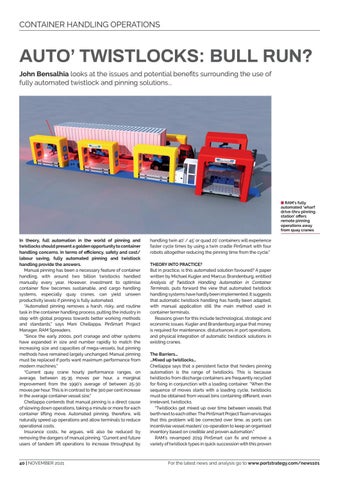CONTAINER HANDLING OPERATIONS
AUTO’ TWISTLOCKS: BULL RUN? John Bensalhia looks at the issues and potential benefits surrounding the use of fully automated twistlock and pinning solutions...
8 RAM’s fully automated ‘wharf drive-thru pinning station’ offers remote pinning operations away from quay cranes
In theory, full automation in the world of pinning and twistlocks should present a golden opportunity to container handling concerns. In terms of efficiency, safety and cost/ labour saving, fully automated pinning and twistlock handling provide the answers. Manual pinning has been a necessary feature of container handling, with around two billion twistlocks handled manually every year. However, investment to optimise container flow becomes sustainable, and cargo handling systems, especially quay cranes, can yield unseen productivity levels if pinning is fully automated. “Automated pinning removes a harsh, risky, and routine task in the container handling process, putting the industry in step with global progress towards better working methods and standards,” says Mani Chellappa, PinSmart Project Manager, RAM Spreaders. “Since the early 2000s, port cranage and other systems have expanded in size and number rapidly to match the increasing size and capacities of mega-vessels, but pinning methods have remained largely unchanged. Manual pinning must be replaced if ports want maximum performance from modern machines.” “Current quay crane hourly performance ranges, on average, between 25-35 moves per hour, a marginal improvement from the 1990’s average of between 25-30 moves per hour. This is in contrast to the 300 per cent increase in the average container vessel size.” Chellappa contends that manual pinning is a direct cause of slowing down operations, taking a minute or more for each container lifting move. Automated pinning, therefore, will naturally speed up operations and allow terminals to reduce operational costs. Insurance costs, he argues, will also be reduced by removing the dangers of manual pinning. “Current and future users of tandem lift operations to increase throughput by
40 | NOVEMBER 2021
handling twin 40’ / 45’ or quad 20’ containers will experience faster cycle times by using a twin cradle PinSmart with four robots altogether reducing the pinning time from the cycle.” THEORY INTO PRACTICE? But in practice, is this automated solution favoured? A paper written by Michael Kugler and Marcus Brandenburg, entitled Analysis of Twistlock Handling Automation in Container Terminals, puts forward the view that automated twistlock handling systems have hardly been implemented. It suggests that automatic twistlock handling has hardly been adapted, with manual application still the main method used in container terminals. Reasons given for this include technological, strategic and economic issues. Kugler and Brandenburg argue that money is required for maintenance, disturbances in port operations, and physical integration of automatic twistlock solutions in existing cranes. The Barriers… …Mixed up twistlocks… Chellappa says that a persistent factor that hinders pinning automation is the range of twistlocks. This is because twistlocks from discharge containers are frequently recycled for fixing in conjunction with a loading container. “When the sequence of moves starts with a loading cycle, twistlocks must be obtained from vessel bins containing different, even irrelevant, twistlocks. “Twistlocks get mixed up over time between vessels that berth next to each other. The PinSmart Project Team envisages that this problem will be corrected over time, as ports can incentivise vessel masters’ co-operation to keep an organised inventory based on credible and proven automation.” RAM’s revamped 2019 PinSmart can fix and remove a variety of twistlock types in quick succession with this proven
For the latest news and analysis go to www.portstrategy.com/news101
















